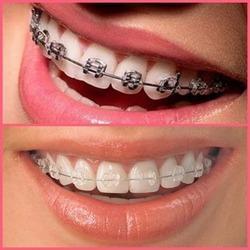Frequently Asked Questions
Here are the questions and answers that are most frequently asked of us.
1. Is it required that I be referred by my family dentist to schedule an appointment with our Orthodontist?
No, it is not. Although most of our patients are referred by their family dentist, many patients who have concerns about their health and appearances and want to be evaluated as to the need for orthodontic care, take the initiative themselves to schedule an initial examination.
2. At what age should I schedule an appointment for an orthodontic screening?
The American Association of Orthodontics recommends an orthodontic screening at age seven. By this age, the six-year molars and several permanent teeth in most children have erupted allowing our Orthodontist to effectively evaluate most developing orthodontic problems.
3. Will, my child’s teeth straighten out on their own as they grow?
No, they will not. The space available for the front teeth does not increase as a child grows. In most people, after the permanent 6-year molars erupt, the space available for the front teeth actually decreases with age.
4. Is there a cost for the initial examination?
No, there is no cost for the initial examination. our Orthodontist believes that the relationship established during a patient’s first visit is much more important than an “office visit” charge.
5. What will happen at the initial examination appointment?
Upon arriving at our Orthodontist’s office, each patient and parent will be greeted and asked to fill out a patient information card that includes some personal information and a brief medical history. our Orthodontist will conduct a brief but thorough examination of the patient’s mouth to determine if there is a need for orthodontic treatment. She will be looking to determine if there is enough room to hold all of your teeth. If the top teeth are lined up correctly with the bottom teeth, if any teeth are crooked or not growing in the right position, and if there are missing or extra teeth. She will also be asking the patient if they are experiencing any breathing problems, have had any finger or tongue habits, and have experienced any jaw joint problems.
6. What will I learn from the initial examination?
There are five important questions that will be answered during the initial examination: Is there an orthodontic problem and if so, what is it? What must be done to correct the problem? Will any permanent teeth need to be removed? How long will the treatment take to complete? How much will the treatment cost? In addition to these, our Orthodontist will take the time to answer any other questions a patient or parent my have.
7. Will I have to have any teeth removed for braces?
Removing teeth is sometimes needed to get the best orthodontic result. Straight teeth, a good bite, and a balanced facial profile are always the goal. However, because today’s technology has resulted in advanced orthodontic procedures, the need for removing teeth has been greatly reduced.
8. How long will it take to complete treatment?
Treatment time obviously depends on each patient’s specific orthodontic problem. In general, treatment times range from 15 to 28 months.
9. How much will braces cost? Are financing options available? How does my insurance work?
It is impossible to give an exact cost for treatment until our Orthodontist has actually examined you or your child. The exact cost and financial options will be discussed at the initial examination. We have many financing options available to meet most needs and will be happy to review them with you. We do file insurance on your behalf. We also offer a discount for fees paid in full. Proper orthodontic treatment to correct a problem is often less costly than the additional dental care required to treat the more serious problems that can develop in later years.
10. How often will I have appointments?
Appointments are scheduled according to each individual patient’s needs. Most patients in braces will be seen every four (4) to six (6) weeks. If there are specific situations that require more frequent monitoring, appointments may be scheduled more often.
11. Can I have all of my appointments after school?
This is a very common question. Unfortunately, we cannot schedule all appointments for all student patients for after-school hours. However, because most appointments are scheduled for to six weeks apart, most patients miss very little school because of orthodontic appointments. The first on or two appointments may have to be scheduled during the day and thereafter can be scheduled after school.
12. Can I drop my child off for an appointment?
We are very understanding of busy schedules and working parents’ desire to run errands while their child is at our office. On some occasions, our Orthodontist may want to speak with parents when you return, so we request that parents check-in with the front desk staff as they schedule their next appointment.
13. Do braces hurt?
As a general rule, braces do not “hurt”. After some visits, teeth may be sore for a few days. In these situations, pain medications such as Advil or Tylenol can be used to ease the discomfort. However, after most visits, patients do not feel any soreness at all. We often remind our patients, it does not have to hurt to work.
14. Can my child return to school the day they receive their braces?
Yes. There is no reason to miss school/work because of an orthodontic appointment.
15. Do you give shots?
No. No shots are necessary for orthodontic treatment.
16. Do you use recycled braces?
ABSOLUTELY NOT! We do not use, worn or recycled braces.worn, used or recycled braces.
17. Can I still play sports an/or musical instruments while in braces?
Yes. We will provide you with a mouth guard for all sports. If you play a musical instrument, it will take your tongue a few days to adapt to the orthodontic appliances and should not, in most cases, stop you from playing.
18. Do I need to see my family dentist while in braces?
Yes. Regular checkups with your family dentist are very important while in braces. Your family dentist will determine how often you should be seen for cleaning appointments while you are in braces.
19. Are there foods I cannot eat while I have braces?
Yes. Once treatment begins very complete instructions and a comprehensive list will be provided regarding foods to avoid. Some of those foods include ice, hard candy, raw vegetable, and all sticky food, I.e. “snickers”, gum, caramel and taffy. May emergency appointments repair broken or damaged braces can be avoided by carefully following instructions regarding foods.
20. How often should I brush my teeth while in braces?
Patients should brush their teeth at least four times each day: after breakfast, lunch (or as soon as they get home from school), supper, and before going to bed. We will show each patient how to floss their teeth with the braces on and will also provide a prescription for a special fluoride gel to help protect teeth.
21. What is an emergency appointment? How are those handled?
If something happens and your braces are causing pain or if something is broken, you should call our office. In most cases, we can address most issues over the telephone.
22. What if the emergency occurs after normal office hours?
Our office is available after normal working hours by pager. Simply call the office and wait for the answering machine to answer. The recorded message will give you an emergency phone number. We will call you as soon as possible. Any time you are unsure of a situation our staff will be glad to assist you.
23. Can orthodontic correction occur while a child still has some baby teeth?
Yes. However, we do not require braces for every patient who visits our office. Some orthodontic problems are significant enough to require early intervention. However, if a patient is not yet ready for treatment, we will follow that patient’s growth an development until the time is right for treatment to begin.
24. What is Phase One (Phase I), early treatment?
Phase One treatment is usually initiated to children between the ages of seven and ten. Phase one treatment usually takes about 12 to 18 months. There are two primary objectives for Phase One treatment. First to develop the jaw so that it will accommodate all of the permanent teeth and to properly relate the upper and lower jaws to each other. Secondly, to improve a child’s psychological self-image and self-esteem, both very important during their formative years.
25. Will my child need full braces if he/she has Phase One treatment?
It is best to assume that your child will need full braces even after Phase One treatment. The period of time following Phase One treatment is called the “resting period”, during which growth and tooth eruption are closely monitored. Throughout this period, parents and patients will be kept informed as to any future treatment recommendations.
26. Will my child need an expander?
At the completion of the initial examination, our Orthodontist will determine whether a patient will require expanders or not.
27. Is it too late to have braces if I am already an adult?
More than 20% of our Orthodontist’s patients are adults. In fact, orthodontic treatment for adults is one of the most gratifying areas of our Orthodontist’s practice for both patients and staff members. Health, happiness and self-esteem are vitally important to adults. No patient is “too old” to wear braces.
28. Can I wear braces even though I have crowns and missing teeth?
Yes. A tooth with a crown will move just like a tooth with a simple filling. When teeth are missing, orthodontic treatment will aid in the alignment of the remaining teeth, so that the space where the teeth are missing can be properly restored.
For more questions please visit our other website
Read More »



